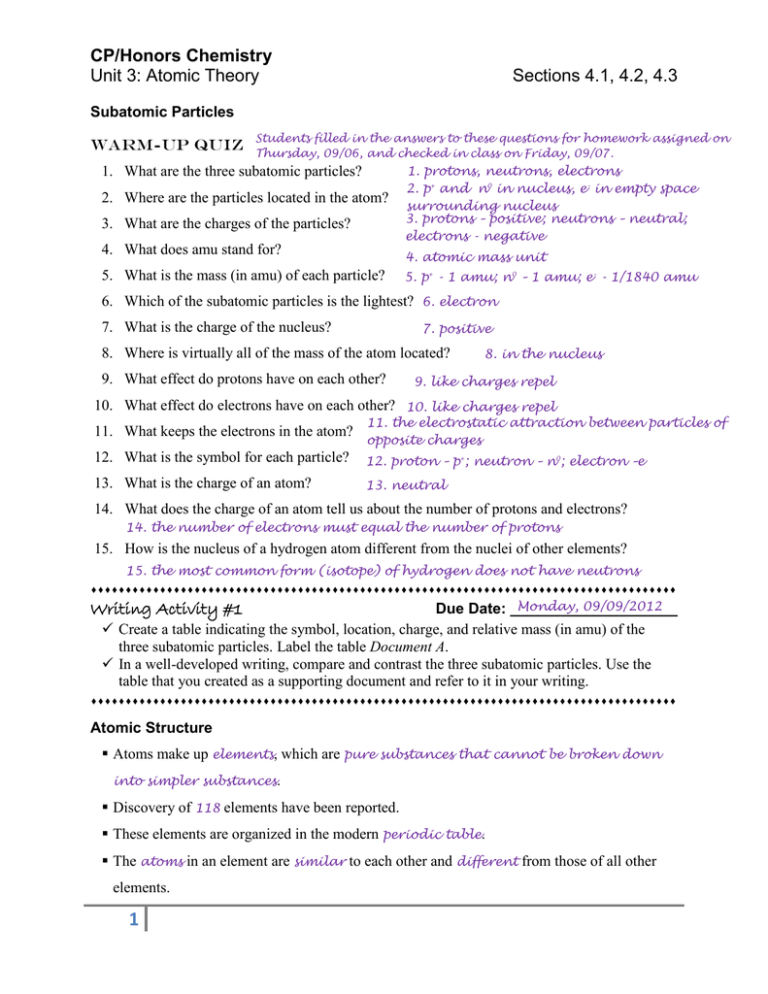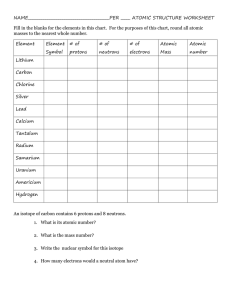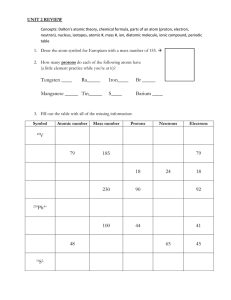Atomic Theory & Subatomic Particles: Chemistry Worksheet
advertisement

CP/Honors Chemistry Unit 3: Atomic Theory Sections 4.1, 4.2, 4.3 Subatomic Particles Warm-Up Quiz Students filled in the answers to these questions for homework assigned on Thursday, 09/06, and checked in class on Friday, 09/07. 1. What are the three subatomic particles? 2. Where are the particles located in the atom? 3. What are the charges of the particles? 4. What does amu stand for? 1. protons, neutrons, electrons 2. p+ and n0 in nucleus, e– in empty space surrounding nucleus 3. protons – positive; neutrons – neutral; electrons - negative 4. atomic mass unit 5. What is the mass (in amu) of each particle? 5. p+ - 1 amu; n0 – 1 amu; e– - 1/1840 amu 6. Which of the subatomic particles is the lightest? 6. electron 7. positive 7. What is the charge of the nucleus? 8. Where is virtually all of the mass of the atom located? 9. What effect do protons have on each other? 8. in the nucleus 9. like charges repel 10. What effect do electrons have on each other? 10. like charges repel 11. What keeps the electrons in the atom? 11. the electrostatic attraction between particles of opposite charges 12. What is the symbol for each particle? 12. proton – p+; neutron – n0; electron –e 13. What is the charge of an atom? 13. neutral 14. What does the charge of an atom tell us about the number of protons and electrons? 14. the number of electrons must equal the number of protons 15. How is the nucleus of a hydrogen atom different from the nuclei of other elements? 15. the most common form (isotope) of hydrogen does not have neutrons Monday, 09/09/2012 Writing Activity #1 Due Date: ____________________ Create a table indicating the symbol, location, charge, and relative mass (in amu) of the three subatomic particles. Label the table Document A. In a well-developed writing, compare and contrast the three subatomic particles. Use the table that you created as a supporting document and refer to it in your writing. Atomic Structure Atoms make up elements, which are pure substances that cannot be broken down into simpler substances. Discovery of 118 elements have been reported. These elements are organized in the modern periodic table. The atoms in an element are similar to each other and different from those of all other elements. 1 Atomic Number The Periodic Table (PT) provides information about each element and organizes the elements in order of increasing atomic number. The atomic number appears below the element name on the periodic table. Equal to the number of protons, which is equal to the number of electrons Protons are responsible for the identity of the element. Electrons are responsible for the chemical properties and behavior of atoms. Since atoms are neutral, atomic number = number of protons = number of electrons In the PT, the element symbol is given underneath its name and atomic number, followed by its atomic mass. Concept Check Students filled in the answers to the next ten questions using the periodic table and the previous notes. protons 1. What determines the identity of an atom? ______ 13 2. What is the atomic number of aluminum? ______ 13 3. How many protons are in one atom of aluminum? ______ 4. How many electrons are in one atom of aluminum? ______ 13 Assume all atoms are neutral, unless otherwise stated. F 9 5. What is the symbol for fluorine? ______ What is its atomic number? ______ S 6. What is the symbol for sulfur? ______ How many protons does sulfur have? ______ 16 Na 11 7. What is the symbol for sodium? ______ How many electrons does sodium have? ______ N nitrogen 8. What is the element with atomic number 7? _______________ What is its symbol? ______ 7 How many protons and electrons does this element have? ______ zinc 9. What is the name of the 30th element? ____________ How many protons and electrons does neutral, no charge 30 this element have? ______ What is the charge of an atom of #30? ______________________ potassium 19 10. What element is symbolized by K? _______________ What is its atomic number? ______ Isotopes The number of neutrons in an atom of a particular element is not always the same. 2 Definition: isotopes are atoms of the same element, meaning they have the same number of protons, that have a different number of neutrons. Same identity; different masses Same number of protons and electrons; different number of neutrons Neutrons are responsible for the isotopes (or different forms) of an atom. Isotopes can be identified by writing the mass number after the element name or symbol. Examples: Hydrogen-1 or H-1, Hydrogen-2 or H-2, Hydrogen-3 or H-3 Concept Check What element is shown in the diagram to the right? lithium How many protons and electrons are in each isotope? Note: Not all electrons are shown. 3 protons, 3 electrons What determines the identity of the element? p Its behavior? e How many neutrons are present in each isotope?3 in the 1 , 4 in the 2 What is the mass in amu for each isotope? 1 : 6 amu; 2 : 7 amu Write the name for each isotope under its diagram. Lithium-6 Lithium-7 Mass Number, Atomic Mass, and Average Atomic Mass + - st st nd nd The mass of an atom is made up of the protons and neutrons in the nucleus; the mass of the electron is insignificant. Therefore, mass number = # of protons + # of neutrons Mass number is always a whole number and can be used with atomic number to calculate the number of neutrons. # of neutrons = mass number - # of protons [AKA atomic number] Mass number does not indicate the actual mass of an atom. The mass of atoms measured in grams is extremely small. More useful to work with relative atomic mass: mass of atom expressed in atomic mass units (amu); mass of one atom in relationship to mass of another (C-12) 1 amu = 1/12 the mass of one atom of carbon-12 (nearly equal to mass of proton or neutron) The average atomic mass is the weighted average mass of the naturally occurring isotopes of an element. Isotopes existing in greater abundance have a greater effect in determining the average atomic mass. Due to weighted nature, atomic masses are not whole numbers but decimals. The average atomic mass appears below the element symbol on the Periodic Table. 3 Rounding the average atomic mass to the nearest whole number gives the mass number for the most abundant isotope of the element. The average atomic mass can be calculated when given atomic mass and percent abundance of an element’s naturally occurring isotopes. Average Atomic Mass = (mass of isotope1)(% abundance as decimal) + (mass of isotope2)(% abundance as decimal) + (mass of isotope3)(% abundance as decimal) etc. Example: Find the weighted average mass of a football team if 92.0% of the players weigh 200. lbs. and 8.00% weigh 180. lbs. Average mass = (200. lbs)(.920) + (180. lbs)(.0800) Average mass = 184 lbs + 14.4 lbs = 198.4 lbs = 198 lbs (to 3SF) Practice. Calculate the average atomic mass for the two naturally occurring isotopes of copper: copper-63 and copper-65. The percent abundance for copper-63 is 69.2%, and its atomic mass is 62.9 amu. The percent abundance of copper-65 is 30.8%, and its atomic mass is 64.9 amu. Avg mass = (62.9 amu)(0.692) + (64.9 amu)(0.308) Avg mass = 63.516 amu Avg mass = 63.5 amu Isotope Names All carbon atoms contain 6 protons because carbon is atomic number 6. One isotope of carbon contains eight neutrons, giving it a mass number of 14 (# protons + # neutrons). The isotope name for this isotope of carbon is written as Carbon-14 or C-14. The carbon isotope containing seven neutrons is Carbon-13 or C-13. Concept Check 1. What is the isotope name for potassium with 21 neutrons? Potassium-40 2. What is the isotope name for oxygen with 9 neutrons? Oxygen-17 3. What does nitrogen-13 (or N-13) mean? Nitrogen-13 or N-13 refers to the isotope of nitrogen with 6 neutrons in its nucleus. Isotopic Notation Isotopic notation or isotope symbol: uses the element symbol, atomic number, and mass number. 14 C 6 4 [Carbon-14] Practice 1. For the carbon isotope above, find the a. Atomic number: 6 b. Number of protons: 6 c. Number of electrons: 6 d. Number of neutrons: 8 22 2. Write the isotopic notation for neon-22. Ne 46 10 Ca 3. Write the isotope symbol for calcium with 26 neutrons. 20 4. Write the name of the isotope having 8 protons and 9 neutrons. oxygen-17 or O-17 Write its isotopic notation. 17 O 8 Charged Particles: Ions The nucleus of an atom has a positive charge. Why? nucleus only contains positively charged protons and neutral neutrons Electrons are negatively charged. Why is the atom electrically neutral? Atoms have equal numbers of positively-charged protons and negatively-charged electrons. Definition of ion: charged atom, resulting from the loss or gain of electrons Definition of anion: negatively-charged ion due to gain of electrons (nonmetals) Example: F Atomic # 9 = # of e– F– gained one electron Definition of cation: positively-charged ion due to loss of electrons (metals) Example: Mg Atomic # 12 = # of e– Mg2+ lost two electrons Isotopic notations for ions show the charge in addition to the symbol, atomic number and mass number. Students completed the following practice during class. Resembles (# e ) Practice 2+ + – 0 1. Mg # p = ______ #e = ______ #n = ______ 12 10 12 Neon – 2. Al3+ # p+ = ______ 13 #e– = ______ 10 #n0 = ______ 14 Neon 3. N3– # p+ = ______ 7 #e– = ______ 10 #n0 = ______ 7 Neon 4. O2– # p+ = ______ 8 #e– = ______ 10 #n0 = ______ 8 Neon – 5. F + # p = ______ 9 10 #e = ______ – 0 Neon 0 10 #n = ______ 3– # p = ______ 15 #e = ______ 18 #n = ______ 16 Argon 7. K+ 19 # p+ = ______ 18 #e– = ______ 20 #n0 = ______ Argon 8. Cl– # p+ = ______ 17 #e– = ______ 18 #n0 = ______ 19 Argon 6. P + – 5 Identifying Characteristics of Atoms Using the square for silicon from the Periodic Table, identify the following: 1. Element Symbol 2. Atomic Number Silicon 3. Number of Protons 14 Si 28.086 4. Number of Electrons 5. (Average) Atomic Mass 6. Mass Number (round atomic mass to the nearest whole number) 7. Number of Neutrons 8. Write the isotopic notation for the most common isotope of silicon. Using the square for manganese from the Periodic Table, identify the following: 1. Element Symbol 2. Atomic Number Manganese 3. Number of Protons 25 Mn 54.938 4. Number of Electrons 5. (Average) Atomic Mass 6. Mass Number (round atomic mass to the nearest whole number) 7. Number of Neutrons 8. Write the isotopic notation for the most common isotope of manganese. Calculating Average Atomic Mass Using the isotope data in the table below, calculate the average atomic mass and determine the identity of the element. Mass (amu) 49.946 Percent Abundance 4.3% 51.941 83.8% 52.941 9.5% 53.939 2.4% Practice What is the atomic number for thallium? ____ What is the element symbol? ____ How many protons are in an atom of radium? ____ How many electrons? ____ How many protons are in an atom of cerium? ____ How many neutrons? ____ 6 Explain (using complete sentences) how to determine the number of neutrons an atom contains if its mass number and atomic number are known. What is the mass number of potassium-39? ____ How many neutrons are in P-39? ____ Concept Check 1. Lithium, which has an atomic mass of 6.9408 amu, has two naturally occurring isotopes, Li-6 and Li-7. Which isotope occurs in greater abundance? 2. Chlorine has two naturally occurring isotopes, Cl-35 and Cl-37. The average atomic mass of chlorine is 35.453 amu. Which isotope occurs in greater abundance? 3. How do you determine which isotope is in greater abundance (when not given percent abundance)? Writing Activity #2 Different elements assigned to students in class Due Date: ____________________ Your assigned element: ____________________ In a well-developed writing piece, explain the terms atomic number, atomic mass, and mass number. Use your assigned element as a specific example to support your explanation. Be sure to include the number many protons, neutrons, and electrons an atom of your assigned element would have. Writing Activity #3 Due Date: ____________________ Compare the following isotopes: 12 13 C 14 C 6 C 6 6 Atomic # ______ Atomic # ______ Atomic # ______ Mass # ______ Mass # ______ Mass # ______ # Protons ______ # Protons ______ # Protons ______ # Neutrons ______ # Neutrons ______ # Neutrons ______ # Electrons ______ # Electrons ______ # Electrons ______ In a well-developed paragraph, thoroughly explain how these isotopes are similar and how they are different. Use specific details from the carbon examples to support your explanation. 7 ESSENTIAL VOCABULARY ANION ATOM ATOMIC MASS ATOMIC MASS UNIT 8 ATOMIC NUMBER CATION ELECTRON ION ISOTOPES MASS NUMBER NEUTRON NUCLEUS PROTON




